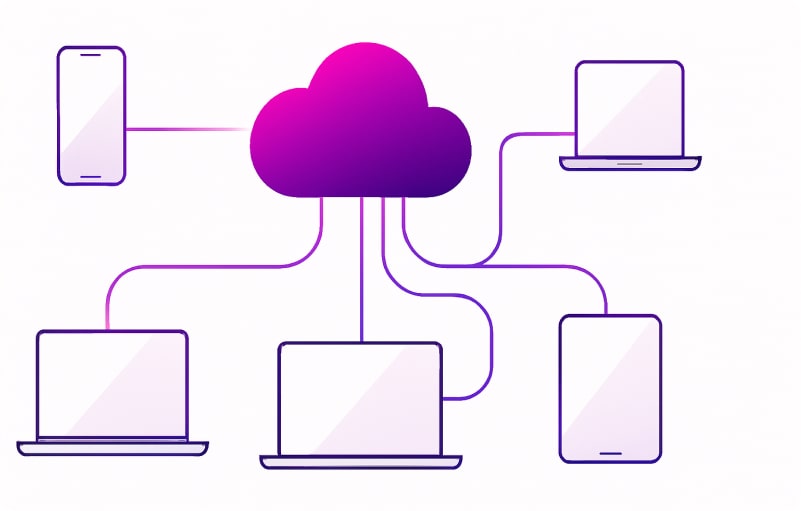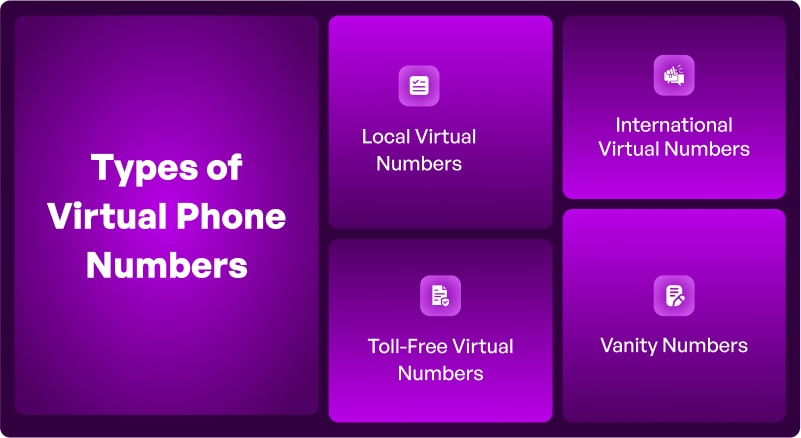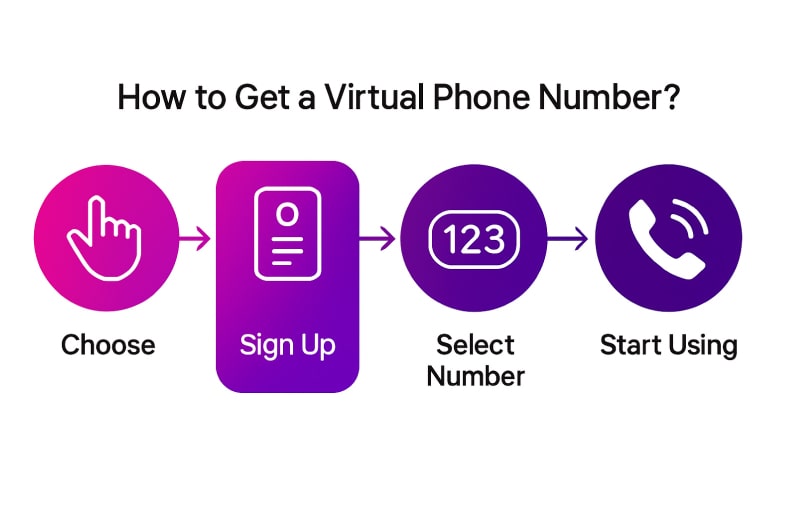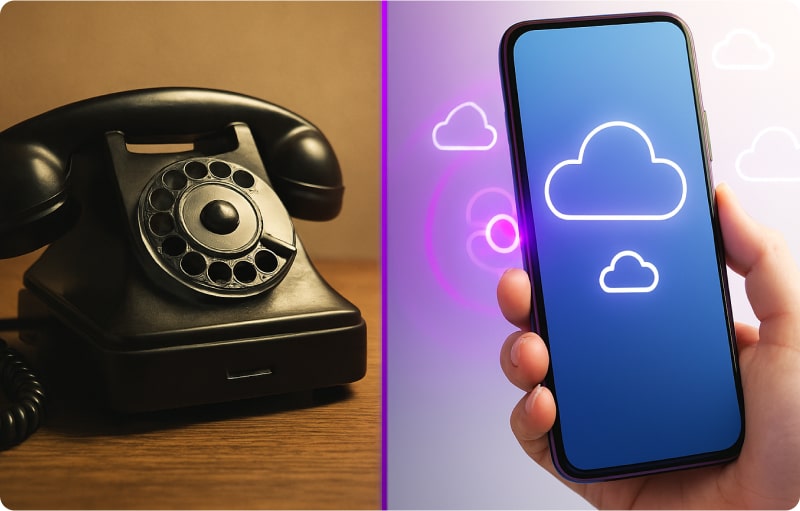
Virtual phone numbers are a mainstream communication tool today. Businesses leverage these numbers to manage multiple customer touchpoints without investing in complex hardware, while individuals use them for privacy and flexibility. Their ability to operate across devices and locations makes them an attractive alternative to traditional telephony. Let’s get into more depth about virtual numbers, what they can do for businesses, and how to get a virtual phone number.
What is a Virtual Phone Number?
A phone number that isn’t bound to a physical phone line, device, or location – that’s the essence of a virtual phone number. It’s a cloud-based number that works via the internet using technologies like VoIP. Unlike traditional landlines, which are wired to specific locations and can be accessed only from those spots, virtual phone numbers utilize software to route calls to any device.

For instance, someone calls a travel agency in New York by dialing their virtual phone number, which is routed to a travel agent’s mobile phone in a coffee shop in Paris. These numbers offer an incredible amount of flexibility and professional image without the need for a physical telephone line or office.
Sometimes the best way to understand a topic is to start with the conversations already happening. As one Reddit thread asked:
Virtual Phone Numbers: Are They Worth the Hype?
How often do you find yourself using a virtual phone number for personal or professional reasons? Why do you prefer it over a traditional landline or mobile number? Source
Let’s understand virtual phone numbers with one more example.
Suppose you are a freelance writer. You want to appear professional, but you don’t want to share your personal phone number with clients and want to demonstrate your global presence as well. So you get yourself multiple virtual phone numbers, like 212 for New York City, 303 for …. Now, when a client calls your 212 number, it rings on your mobile phone. It helps you keep your image professional and also keeps your personal number private.
Why Virtual Phone Numbers Matter to Your Business?
Suppose you are a business that’s still using traditional landlines or mobile numbers to attend customer calls. In that case, you’re missing out on a smarter, more efficient, and professional way to manage your business communication. Startups that are trying to expand internationally, or enterprises managing remote teams, use virtual numbers to ensure seamless connectivity. In today’s digital world, virtual numbers are not just a tech trend or a matter of convenience; they are strategic business tools that are essential for growth.
How do Virtual Phone Numbers Work?
We all use regular phone numbers, right? Just think of virtual numbers to be the same, but without the physical SIM card or phone line tied to it. The underlying technology is VoIP, i.e., Voice over Internet Protocol. Here’s what happens behind the scenes:
1. Call Initiation: It is Sent to the Cloud
When a client dials a virtual phone number, the call is sent over the public telephone network or the internet to a cloud-based server managed by the virtual phone number provider.
2. Call Routing: Server Consults the Rules
As soon as the call reaches the server, the server checks the call routing rules, which are preconfigured in the system. Typically, these rules are configured based on time zones, location, or agent availability.
3. Call Transmission: VoIP Comes In
Based on the routing rules, the server makes use of VoIP to convert the call’s audio into small data packets. These packets are then transmitted over the Internet to the designated device.
4. Call Delivery: It Reaches the Destination
At the receiving end, the data packets are reassembled. This means that the data is converted back into a voice call. The call can be received on a mobile phone, via an app, a computer, using a softphone, or a VoIP-enabled desk phone.
5. Outbound Calls and Caller ID
In the case of outgoing calls, i.e., when you make an outbound call using your virtual phone number, the above process is reversed. Your device sends the call data to the virtual phone provider’s server, which then uses your virtual number as the caller ID. This ensures that your professional number is displayed to the recipient, even if you are calling from your cell phone, maintaining a consistent and professional brand identity.
Essential Features of Virtual Phone Numbers
We learnt that virtual phone numbers eliminate a business’s dependency on traditional wired phone connections, offering them the flexibility to route calls as they need. But these numbers offer a lot more than that – they come packed with powerful features that go far beyond just making and receiving calls. In other words, they power your basic communication with a suite of advanced capabilities. Let’s learn about the features of virtual phone numbers:
1. Call Forwarding & Routing
A core functionality of virtual numbers. By setting predefined rules, you can easily redirect calls to any device- a mobile phone, a computer, or another landline. This feature makes virtual numbers perfect for remote teams or 24/7 support. Many advanced cloud telephony systems come with the feature of intelligent routing, using which you can route the call to the right agent, department, or device, based on time, location, or custom rules.
2. Interactive Voice Response (IVR)
This acts as your virtual receptionist. So every time a call arrives, it greets the callers with prerecorded greetings and creates a professional first impression with a multi-level IVR menu (e.g., “Press 1 for Sales, 2 for Support…”). This not only improves the caller experience but also saves time by guiding users directly to the right destination. Besides this, it efficiently handles call volume, which becomes difficult in the case of a human receptionist.
3. Call Recording
This feature helps you record incoming and outgoing calls that happen over your virtual phone number. Call recording is an invaluable business tool for training, compliance, dispute resolution, and quality control. These recordings are stored in the cloud and can be easily accessed and reviewed later.
4. SMS Integration
Many virtual numbers support text messaging, allowing businesses to use the same number for calling and texting their customers. This makes it easier to send updates, confirmations, or promotions, and even engage in two-way customer interactions right from your dashboard.
5. Voicemail-to-Email
When a caller leaves a voicemail, the system automatically transcribes the message and sends it to your email inbox. This allows you to read voicemails on the go without having to dial in, making it easier to prioritize and respond to messages.
6. Analytics & Reporting
A virtual phone number system provides detailed data on your call activity. You can track call volumes, peak hours, response times, missed calls, agent performance, and more. These insights help optimize operations, evaluate campaigns, and boost customer satisfaction.
7. CRM & Helpdesk Integration
Another extremely useful feature of virtual numbers is that they allow businesses to integrate their phone systems with CRMs, allowing agents to view caller history, notes, and past interactions in real-time.
Different Types of Virtual Phone Numbers

Virtual phone numbers come in different forms, each one to suit specific business needs. Here’s a quick breakdown of the most common types of virtual numbers:
Local Numbers
Are you a business based in India but targeting customers in New York? Local numbers are for you. These phone numbers come with area codes specific to a location, such as a region or city.
Local phone numbers matter to businesses because people are more likely to answer calls from familiar area codes. This fact makes them great for boosting trust and call pick-up rates.
Toll-Free Numbers
Do you want to create a professional brand image and receive a lot of inbound calls for support and sales inquiries? Toll-free numbers are for you. These numbers usually begin with prefixes like 800, 888, 877, etc., and the customer isn’t charged for the call.
International Numbers
Do you want to establish a global presence by having phone numbers from multiple countries? International numbers help you achieve that. For example, a UK-based business gets virtual numbers in the UAE and the USA for global reach without having physical offices.
Vanity Numbers
Businesses operating in the retail and service sectors often prefer branding to enhance promotion. Vanity numbers are useful in such situations because these numbers spell out words like 1-800-FLOWERS.
How to Get a Virtual Phone Number?

Getting a virtual phone number may sound like going through a lot of technical processes, but surprisingly, it is easy. You don’t need any hardware or a SIM card, because everything runs over the internet. Here’s the step-by-step process.
- Look for a trusted virtual phone system provider
- Pick your number type and the location
- Configure your routing rules and features
- Integrate with your existing tools
- Go live and start using
How Much Does a Virtual Number Cost?
An obvious concern that arises among many businesses at the buying stage is the cost of the virtual phone numbers. Local numbers are typically the most affordable, while toll-free numbers are a little expensive because the business pays for the call, and vanity phone numbers have premium costs due to their customizability.
Here’s a table that highlights the estimated cost range of different types of virtual phone numbers:
| Type of Number | Average Monthly Cost | Notes |
| Local Number | $1 – $10 | Cost varies by country and area code |
| Toll-Free Number | $10 – $30 | Inbound call rates may apply |
| International Number | $5 – $50 | Varies significantly by region |
| Mobile Virtual Number | $2 – $15 | Includes SMS/WhatsApp capabilities |
| Vanity Number | $10 – $100+ | Premium pricing due to customization |
Benefits of Using Virtual Phone Numbers
Virtual phone numbers are beneficial for businesses of all sizes- startups, remote companies, and even global enterprises. Let’s learn more about the top benefits:
- No More Need for Physical Offices
With virtual numbers, you can get a phone number in any city or country, without opening an office there.
- Portability & Remote Access
Your team can answer business calls on any device and from any place. It is your business phone line in your pocket
- Advanced Call Routing & IVR
Virtual numbers come with various features like Auto-attendants (IVR), call forwarding to multiple devices, and Voicemail-to-email.
- Improved Customer Support & Engagement
With toll-free or local virtual numbers, customers can easily reach the business. Also, with dedicated numbers assigned to agents for specific campiagns, boosts business’s service.
- Cost-Effective Communication
There’s no requirement of hardware investment, no expensive PBX, and no international calling charges. Virtual numbers help businesses save a lot.
- Easy Scalability
Adding more agents instantly isn’t an issue with virtual phone numbers. One can just assign the numbers in minutes.
- Better Analytics and Call Insights
Virtual numbers enable businesses to track every call metric – missed call, call duration, response rate, call outcome, and even agent performance
- Integration with Business Tools
Virtual phone numbers support centralizing communication by integrating with existing CRMs, helpdesk tools, and ERPs, making life a lot easier.
How Businesses Use Virtual Phone Numbers?

Let’s look at real-world use cases across industries:
1. Customer Support & Helpdesks
Businesses with customer support departments assign dedicated virtual numbers to their support agents and teams. When customer calls arrive, IVR and call queues function to route the calls to the right agents, reducing wait times.
2. Sales & Lead Management
Click-to-call feature of the virtual phone numbers is often utilized by sales teams to generate leads and improve conversions.
3. International Expansion
Businesses targeting new geographical locations around the globe can purchase virtual phone numbers in the target regions and route calls to their central HQ.
4. Remote or Hybrid Teams
Virtual numbers come as an excellent replacement for desk phones. Remote agents working from different locations can answer customer calls using softphone apps or desktop browsers.
5. Business Continuity & Disaster Recovery
Businesses using on-site PBS systems can benefit from virtual numbers when their PBX fails or there’s a sudden office shutdown. Calls can be routed instantly to mobiles or alternative devices.
How to Choose the Right Virtual Phone Number?
Every business has unique requirements. So when it comes to picking the right virtual phone number, you simply can’t get any number. You need a number that truly supports your business growth and aligns well with your communication goals. Here’s what you need to consider:
What’s the Purpose?
Figure out the reason for using the virtual phone number. Is it for customer support, sales calls, marketing campiagns, or internal communication?
What Type of Number Do you Need?
You have various options – local, toll-free, vanity, or international numbers. Considering your target audience, choose an appropriate type of number.
What All Features do You Want?
Prepare your checklist and ensure that you do not miss the essential ones – call forwarding, voicemail-to-email, IVR menus, call recording, and analytics.
Do not Skip Scalability
As you expand into new markets, you need a solution that grows along. So, look for a provider that enables you to add more numbers without any hassle.
Consider Value for Money
A low-cost number plan might not offer the desired benefits. It is better to consider the value you get for the price. Check if there are hidden fees for international calls or additional features.
Opt for A Reputable Vendor
Last but not least, make sure you choose a reputable provider. This helps you gain good uptime, quality customer support, and strong security measures to protect your calls and data.
Virtual vs Regular Phone Numbers

While a standard number and a virtual phone number are both just sets of digits, it is their features and functionality that make a lot of difference.
1. Technology
Regular phone numbers are tied to a specific phone line or SIM card. These numbers work over traditional landlines or mobile networks.
Virtual phone numbers are cloud-based and are not bound to a single device. You can answer calls on a smartphone, laptop, or even a desk phone with an internet connection.
2. Location Dependence
Regular numbers are fixed to a specific location or carrier. If you move or travel, you might lose the number or pay high roaming charges.
Virtual numbers are location-independent. You can make and receive calls anywhere in the world with an internet connection.
3. Features
Regular number offers only basic calling and texting, maybe voicemail sometimes.
Virtual numbers offer advanced features like call forwarding, auto-attendant, voicemail transcription, call analytics, and multi-device ringing.
4. Cost
Regular numbers often involve setup fees, maintenance costs, and higher international calling rates.
Virtual numbers are usually cheaper, with flexible pay-as-you-go or subscription models.
5. Business Use
Regular numbers are good for personal use or small-scale communication.
Virtual numbers are ideal for businesses that need scalability, multi-location support, and professional call management.
Conclusion
Modern-day communication demands a solution that offers flexibility, cost-effectiveness, and global reach. Virtual numbers provide all of that in an easy-to-manage and professional way. Without tying a business to a fixed location or phone line, these numbers support international expansion, management of remote teams, and even the privacy of individuals. If you need expert consultation about how to get a virtual phone number or which phone number will be best for your business, get in touch with us.
Frequently Asked Questions
Are virtual numbers and online telephone numbers the same?
Yes, both are the same. These terms are often used interchangeably, referring to phone numbers that work over the internet.
How many virtual phone numbers can I have for my business?
You can have as many virtual numbers as you want. Many businesses use different types of virtual numbers for their different departments.
How secure are virtual phone numbers?
Reputable virtual phone numbers ensure robust security measures like encryption, 2FA, and spam filtration to keep communication secure.
Can I keep my virtual phone number if I change my provider?
Yes, you can. Most of the virtual number providers offer number portability, which means you can transfer your existing virtual number to another provider.
Is there any special hardware requirement for virtual numbers?
No, virtual numbers can be used on smartphones, desktops, and VoIP deskphones. You just need a strong and stable internet connection.






















